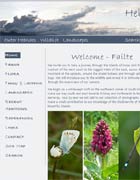 South Uist has a varied landscape that supports a number of habitats. A sandy beach runs along the west coast and stretches over twenty miles. Beachcombers often find beautiful shells and spot inshore marine animals while seals watch from the surf.
South Uist has a varied landscape that supports a number of habitats. A sandy beach runs along the west coast and stretches over twenty miles. Beachcombers often find beautiful shells and spot inshore marine animals while seals watch from the surf.
In the spring and summer months, the machair foothills and farmlands bloom with a colourful array of wildflowers that include harebells, orchids, clovers, eyebright, iris', gentian and primroses. In the autumn, the hills seem to turn bright purple as heather begins to bloom.
The beach and adjoining machair land with its sandy soil and numerous shallow lochs provide a habitat for wading birds that include Dunlins, Lapwings, and Redshanks. About 150 species of birds are known to breed in Uist and include Red Breasted Mergansers, Eiders, Wigeons and Mute Swans.
Further inland and around the croft, the endangered Corncrake can sometimes be heard, while Twites and Corn Buntings are more commonly seen. Kestrels, Merlins, and even the occasional Short Eared Owl are spotted around the farmlands while other raptors such as Peregrine Falcons, Merlins, Golden Eagles and the occasional White Tailed Eagle tend to be seen closer to the hills and on the eastern coast.
Loch Bee in the north has one of the largest mute swan colonies in Europe while the nature reserve at Loch Druidibeg (about 8 miles north of Milton) is home to Britain's largest surviving colony of Greyling Geese. Altogether, approximately some 286 species of birds can be found in Uist.
As one can imagine, South Uist is renowned for it's variety of bird life and attracts many ornithologists each year. In addition to birds, red deer and other smaller mammals such as voles, rabbits, ferrets and otters are frequently seen throughout the region.click here for more information:
http://www.hebridensis.co.uk/

